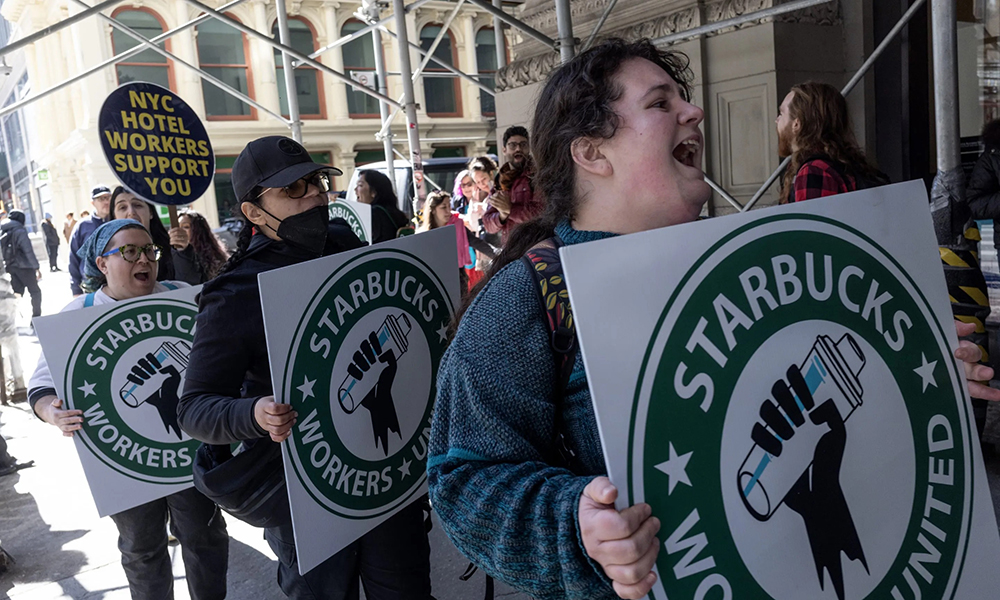
? 若能有效達(dá)成“回歸星巴克”轉(zhuǎn)型戰(zhàn)略中的成本節(jié)約和及時(shí)推廣目標(biāo),星巴克將向高管發(fā)放最高達(dá)600萬美元的股票獎(jiǎng)勵(lì),。在圍繞咖啡師薪資的合同談判期間,,星巴克工人聯(lián)合會(huì)代表稱此舉“荒謬且不負(fù)責(zé)任”。
盡管員工對(duì)星巴克給予咖啡師的薪資待遇發(fā)起抗議,,但星巴克仍在加大對(duì)高管的激勵(lì)力度,,以期加速公司扭虧為盈的進(jìn)程。
根據(jù)上周三提交的文件,,若高管能迅速達(dá)成成本節(jié)約目標(biāo),,這家咖啡連鎖企業(yè)將向他們發(fā)放最高達(dá)600萬美元的股票獎(jiǎng)勵(lì)。這一純粹以業(yè)績?yōu)閷?dǎo)向的激勵(lì)舉措,,旨在推進(jìn)新任首席執(zhí)行官倪睿安(Brian Niccol)提出的“回歸星巴克”計(jì)劃——該計(jì)劃旨在讓星巴克回歸昔日那種溫馨舒適的“第三空間”定位,。
文件中提到:“這些獎(jiǎng)勵(lì)旨在激勵(lì)并留住高級(jí)管理層,,以實(shí)現(xiàn)扭虧為盈計(jì)劃所要求的重大變革。獎(jiǎng)勵(lì)與‘回歸星巴克’計(jì)劃關(guān)鍵環(huán)節(jié)的完成情況直接掛鉤,,以此鼓勵(lì)高級(jí)管理層盡快達(dá)成相關(guān)目標(biāo),。”
文件顯示,,這些目標(biāo)包括推廣星巴克的“綠圍裙服務(wù)”計(jì)劃(該計(jì)劃利用技術(shù)加快訂單處理速度),、“新食品和飲料平臺(tái)”以及“重新設(shè)計(jì)的星巴克會(huì)員獎(jiǎng)勵(lì)計(jì)劃”。員工有資格在星巴克2027財(cái)年結(jié)束時(shí)(即2027年9月)獲得股票獎(jiǎng)勵(lì),。
員工最高可獲得目標(biāo)金額200%的獎(jiǎng)勵(lì),但必須在基于業(yè)績的限制性股票單位歸屬日前持續(xù)在崗,。
自2024年9月就任星巴克首席執(zhí)行官以來,,倪睿安對(duì)這家總部位于西雅圖的咖啡連鎖企業(yè)實(shí)施了全面改革,包括為咖啡師制定綠圍裙著裝規(guī)范,、引入手寫訂單名稱等人性化舉措,,以及重新設(shè)計(jì)招聘流程以充實(shí)門店員工隊(duì)伍。在銷售業(yè)績下滑的背景下,,這位首席執(zhí)行官期望星巴克恢復(fù)昔日聲譽(yù)——彼時(shí)顧客會(huì)在舒適的店內(nèi)座椅上悠然享用拿鐵,。
倪睿安在擔(dān)任首席執(zhí)行官的第一年有望獲得高達(dá)1.13億美元的收入,其中包括160萬美元的基本薪資,、7500萬美元的股權(quán)獎(jiǎng)勵(lì),,以及因在前六個(gè)月留任而獲得的1000萬美元簽約獎(jiǎng)金。
咖啡師對(duì)薪資的不滿
與高管層不同,,星巴克柜臺(tái)后的員工正奮力爭取時(shí)薪的穩(wěn)步增長,。彭博社12月援引一份內(nèi)部文件報(bào)道,2024年咖啡師的薪資漲幅較小,,約為2%至3%,,而此前數(shù)年的漲幅為3%至5%。此次工資漲幅放緩與績效無關(guān),,正值該年星巴克面臨挑戰(zhàn)——在遭遇抵制活動(dòng),、服務(wù)速度放緩后,門店客流量和銷售額均有所下降,。這家咖啡連鎖店向咖啡師支付的平均時(shí)薪為19美元,,加上福利后總計(jì)約為30美元。
加入工會(huì)的星巴克咖啡師在與管理層協(xié)商新合同的過程中,,對(duì)薪資提出異議,。雙方的談判已持續(xù)兩年,今年4月,,星巴克工人聯(lián)合會(huì)拒絕了公司提出的每年至少加薪2%的提議,。星巴克未回應(yīng)《財(cái)富》雜志的置評(píng)請(qǐng)求,。
星巴克上周三披露的高管獎(jiǎng)金等情況,成為員工的又一不滿之處,,尤其是在合同談判期間,。紐約州布法羅市的咖啡師、星巴克工人聯(lián)合會(huì)的談判代表賈思敏·萊利(Jasmine Leli)對(duì)《財(cái)富》雜志表示,,給高管發(fā)放600萬美元獎(jiǎng)勵(lì)足以體現(xiàn)星巴克“荒謬且不負(fù)責(zé)任”,。
萊利在一份聲明中表示:“星巴克不能一方面聲稱資金短缺,無法為咖啡師提供公平合理的工會(huì)合同,,另一方面卻在2024年為倪睿安120天的工作支付高達(dá)9600萬美元,,還為經(jīng)理們舉辦奢華的會(huì)議,并為高管發(fā)放數(shù)百萬美元獎(jiǎng)金,?!貧w星巴克’計(jì)劃只有在咖啡師能夠獲得良好發(fā)展機(jī)遇時(shí)才能成功——而第一步便是敲定一份公平的工會(huì)合同,明確我們工作所需的人員配置,、工作時(shí)長和保障措施,。”
從更宏觀的層面來看,,并非所有咖啡師都認(rèn)同公司的“回歸星巴克”戰(zhàn)略,。今年5月,美國120家門店的2000多名星巴克咖啡師舉行罷工,,稱新著裝規(guī)范并非提升客戶體驗(yàn)的有效舉措,。
星巴克當(dāng)時(shí)在一份聲明中表示:“如果工會(huì)能拿出抗議穿黑襯衫上班的那份勁頭回到談判桌前,那會(huì)更有成效,?!?/p>
其他員工則提議為門店提供更為便捷的方式暫停線上訂單,以緩解咖啡師的工作壓力,。萊利指出,,盡管倪睿安致力于將顧客等待時(shí)間壓縮至30秒,但由于人手短缺和客流量居高不下,,咖啡師依舊難以高效制作飲品,。
“咖啡師是星巴克體驗(yàn)中最為關(guān)鍵的一環(huán),”萊利說道,,“我們尚未看到有關(guān)自身訴求的任何進(jìn)展,,包括更合理的人員配置、保證工作時(shí)長,、提高實(shí)際到手工資以及完善在崗保護(hù)措施,。”(財(cái)富中文網(wǎng))
譯者:中慧言-王芳
? 若能有效達(dá)成“回歸星巴克”轉(zhuǎn)型戰(zhàn)略中的成本節(jié)約和及時(shí)推廣目標(biāo),,星巴克將向高管發(fā)放最高達(dá)600萬美元的股票獎(jiǎng)勵(lì),。在圍繞咖啡師薪資的合同談判期間,,星巴克工人聯(lián)合會(huì)代表稱此舉“荒謬且不負(fù)責(zé)任”。
盡管員工對(duì)星巴克給予咖啡師的薪資待遇發(fā)起抗議,,但星巴克仍在加大對(duì)高管的激勵(lì)力度,,以期加速公司扭虧為盈的進(jìn)程。
根據(jù)上周三提交的文件,,若高管能迅速達(dá)成成本節(jié)約目標(biāo),,這家咖啡連鎖企業(yè)將向他們發(fā)放最高達(dá)600萬美元的股票獎(jiǎng)勵(lì)。這一純粹以業(yè)績?yōu)閷?dǎo)向的激勵(lì)舉措,,旨在推進(jìn)新任首席執(zhí)行官倪睿安(Brian Niccol)提出的“回歸星巴克”計(jì)劃——該計(jì)劃旨在讓星巴克回歸昔日那種溫馨舒適的“第三空間”定位,。
文件中提到:“這些獎(jiǎng)勵(lì)旨在激勵(lì)并留住高級(jí)管理層,以實(shí)現(xiàn)扭虧為盈計(jì)劃所要求的重大變革,。獎(jiǎng)勵(lì)與‘回歸星巴克’計(jì)劃關(guān)鍵環(huán)節(jié)的完成情況直接掛鉤,,以此鼓勵(lì)高級(jí)管理層盡快達(dá)成相關(guān)目標(biāo)?!?
文件顯示,這些目標(biāo)包括推廣星巴克的“綠圍裙服務(wù)”計(jì)劃(該計(jì)劃利用技術(shù)加快訂單處理速度),、“新食品和飲料平臺(tái)”以及“重新設(shè)計(jì)的星巴克會(huì)員獎(jiǎng)勵(lì)計(jì)劃”,。員工有資格在星巴克2027財(cái)年結(jié)束時(shí)(即2027年9月)獲得股票獎(jiǎng)勵(lì)。
員工最高可獲得目標(biāo)金額200%的獎(jiǎng)勵(lì),,但必須在基于業(yè)績的限制性股票單位歸屬日前持續(xù)在崗,。
自2024年9月就任星巴克首席執(zhí)行官以來,倪睿安對(duì)這家總部位于西雅圖的咖啡連鎖企業(yè)實(shí)施了全面改革,,包括為咖啡師制定綠圍裙著裝規(guī)范,、引入手寫訂單名稱等人性化舉措,以及重新設(shè)計(jì)招聘流程以充實(shí)門店員工隊(duì)伍,。在銷售業(yè)績下滑的背景下,,這位首席執(zhí)行官期望星巴克恢復(fù)昔日聲譽(yù)——彼時(shí)顧客會(huì)在舒適的店內(nèi)座椅上悠然享用拿鐵。
倪睿安在擔(dān)任首席執(zhí)行官的第一年有望獲得高達(dá)1.13億美元的收入,,其中包括160萬美元的基本薪資,、7500萬美元的股權(quán)獎(jiǎng)勵(lì),以及因在前六個(gè)月留任而獲得的1000萬美元簽約獎(jiǎng)金,。
咖啡師對(duì)薪資的不滿
與高管層不同,,星巴克柜臺(tái)后的員工正奮力爭取時(shí)薪的穩(wěn)步增長。彭博社12月援引一份內(nèi)部文件報(bào)道,,2024年咖啡師的薪資漲幅較小,,約為2%至3%,而此前數(shù)年的漲幅為3%至5%,。此次工資漲幅放緩與績效無關(guān),,正值該年星巴克面臨挑戰(zhàn)——在遭遇抵制活動(dòng),、服務(wù)速度放緩后,門店客流量和銷售額均有所下降,。這家咖啡連鎖店向咖啡師支付的平均時(shí)薪為19美元,,加上福利后總計(jì)約為30美元。
加入工會(huì)的星巴克咖啡師在與管理層協(xié)商新合同的過程中,,對(duì)薪資提出異議,。雙方的談判已持續(xù)兩年,今年4月,,星巴克工人聯(lián)合會(huì)拒絕了公司提出的每年至少加薪2%的提議,。星巴克未回應(yīng)《財(cái)富》雜志的置評(píng)請(qǐng)求。
星巴克上周三披露的高管獎(jiǎng)金等情況,,成為員工的又一不滿之處,,尤其是在合同談判期間。紐約州布法羅市的咖啡師,、星巴克工人聯(lián)合會(huì)的談判代表賈思敏·萊利(Jasmine Leli)對(duì)《財(cái)富》雜志表示,,給高管發(fā)放600萬美元獎(jiǎng)勵(lì)足以體現(xiàn)星巴克“荒謬且不負(fù)責(zé)任”。
萊利在一份聲明中表示:“星巴克不能一方面聲稱資金短缺,,無法為咖啡師提供公平合理的工會(huì)合同,,另一方面卻在2024年為倪睿安120天的工作支付高達(dá)9600萬美元,還為經(jīng)理們舉辦奢華的會(huì)議,,并為高管發(fā)放數(shù)百萬美元獎(jiǎng)金,。‘回歸星巴克’計(jì)劃只有在咖啡師能夠獲得良好發(fā)展機(jī)遇時(shí)才能成功——而第一步便是敲定一份公平的工會(huì)合同,,明確我們工作所需的人員配置,、工作時(shí)長和保障措施?!?/p>
從更宏觀的層面來看,,并非所有咖啡師都認(rèn)同公司的“回歸星巴克”戰(zhàn)略。今年5月,,美國120家門店的2000多名星巴克咖啡師舉行罷工,,稱新著裝規(guī)范并非提升客戶體驗(yàn)的有效舉措。
星巴克當(dāng)時(shí)在一份聲明中表示:“如果工會(huì)能拿出抗議穿黑襯衫上班的那份勁頭回到談判桌前,,那會(huì)更有成效,。”
其他員工則提議為門店提供更為便捷的方式暫停線上訂單,,以緩解咖啡師的工作壓力,。萊利指出,盡管倪睿安致力于將顧客等待時(shí)間壓縮至30秒,,但由于人手短缺和客流量居高不下,,咖啡師依舊難以高效制作飲品,。
“咖啡師是星巴克體驗(yàn)中最為關(guān)鍵的一環(huán),”萊利說道,,“我們尚未看到有關(guān)自身訴求的任何進(jìn)展,,包括更合理的人員配置、保證工作時(shí)長,、提高實(shí)際到手工資以及完善在崗保護(hù)措施,。”(財(cái)富中文網(wǎng))
譯者:中慧言-王芳
? Starbucks will reward company executives with up to $6 million in stock grants should they effectively fulfill cost-saving and timely rollout goals of the company’s “Back to Starbucks” turnaround strategy. Starbucks Workers United representatives dubbed the move “ridiculous and irresponsible” amid contract negotiations over barista wages.
Starbucks is sweetening the pot for executives to expedite the company’s turnaround efforts, even as workers protest the company’s wages for baristas.
The coffee chain will give its executives up to $6 million in stock grants should they expeditiously deliver on cost-saving goals, according to documents filed Wednesday. The entirely performance-based incentive is in an effort to advance the company’s “Back to Starbucks” plan introduced by new CEO Brian Niccol to return Starbucks to its cozy, third-place roots.
“These grants are designed to motivate and retain our senior leaders to deliver on the significant transformation required by our turnaround plan,” the filing said. “The grants are directly tied to the achievement of key components of the Back to Starbucks plan to encourage our senior leaders to achieve these goals as quickly as possible.”
These goals pertain to the rollout of Starbucks’ Green Apron Service program to leverage technology to expedite orders, as well as “new food and beverage platforms” and “a reimaged Starbucks Rewards program,” per the filing. Employees are eligible to receive the stock grants at the end of Starbuck’s fiscal 2027, which ends in September 2027.
While employees can unlock a payout of up to 200% of the target, they must have worked through the service date of the performance-based restricted stock units.
Upon joining Starbucks as CEO in September 2024, Niccol has rolled out sweeping changes to the Seattle-based coffee chain, including a green apron dress code for baristas, human touches like hand-written order names, and a revamped hiring process to beef up store staffing. Amid slumping sales, the CEO wants to return Starbucks to its reputation of yore, when customers lingered over lattes in comfortable in-store seating.
Niccol stands to make up to $113 million in his first year as CEO, including a base salary of $1.6 million, a $75 million equity grant, and $10 million in signing bonuses for sticking at the job for the first six months.
Baristas’ grievances over wages
Unlike those in the C-suite, Starbucks employees behind the counter are fighting for incremental increases in hourly wages. Baristas last year earned smaller pay increases in 2024—about 2% to 3%—compared to the 3% to 5% increase from years prior, Bloomberg reported in December, citing an internal document. The pullback in wages, which are not tied to performance, came amid a challenging year for Starbucks, in which it battled lower traffic and sales following boycotts and slowing service. The coffee chain pays its baristas $19 an hour on average, totalling about $30 an hour when you include benefits.
Unionized Starbucks baristas have taken issue with wages as they seek to ratify a new contract with management two years after negotiations began, with Starbucks Workers United rejecting a company proposal in April guaranteeing at least a 2% pay increase annually. Starbucks did not respond to Fortune’s request for comment.
Executive bonuses like what Starbucks disclosed on Wednesday are another worker grievance, particularly amid contract negotiations. Jasmine Leli, a barista in Buffalo, New York, and a bargaining delegate with Starbucks Workers United, told Fortune the $6 million incentives for executives is a “ridiculous and irresponsible step for Starbucks.”
“Starbucks cannot tell us that there is no money to put into a fair union contract for baristas when they paid Brian [Niccol] $96 million for 120 days of work in 2024 and have allocated millions upon millions for a glitzy manager conference and C-Suite bonuses,” Leli said in a statement. “‘Back to Starbucks’ will only succeed when baristas can thrive—and the first step is finalizing fair union contracts that lock in the staffing, hours, and protections we need to do our jobs.”
Not all baristas are sold on the company’s “Back to Starbucks” strategies more broadly. More than 2,000 Starbucks baristas at 120 U.S. stores went on strike in May, arguing the new dress code was not a relevant step to improve the customer experience.
“It would be more productive if the union would put the same effort into coming back to the table that they’re putting into protesting wearing black shirts to work,” Starbucks said in a statement at the time.
Other workers have advocated for an easier way for stores to pause digital orders to mitigate overwhelm among baristas. Leli indicated baristas are still struggling to make drinks efficiently due to understaffing and high traffic volumes, despite Niccol’s efforts to decrease wait times to just 30 seconds.
“Baristas are the most important part of the Starbucks experience,” Leli said. “We’ve yet to see any progress in our demands including better staffing, guaranteed hours, improved take-home pay, and on-the-job protections.”






